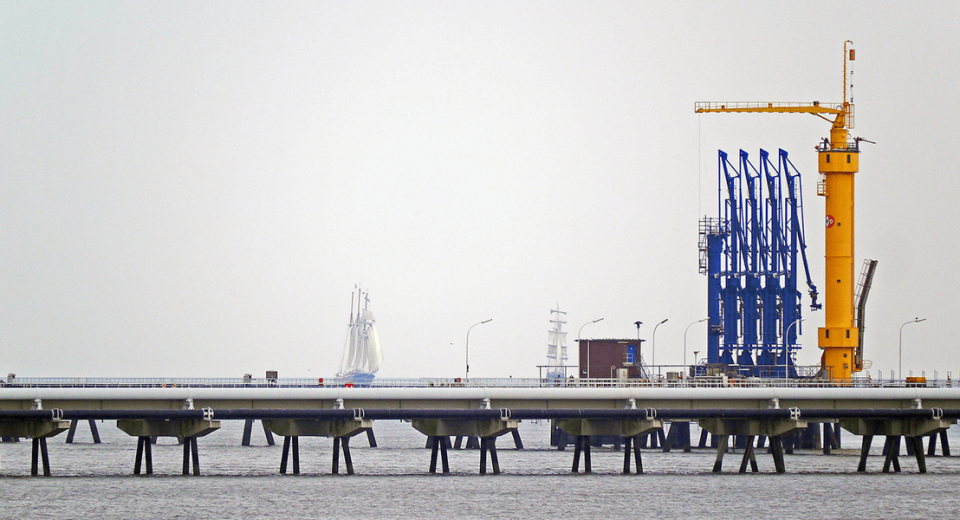The 2020 Oil Crash

The COVID-19 pandemic in 2020 has led to widespread lockdowns across the world. Movement of people and economic activities have significantly been curbed. As a result, global oil demand is seeing its sharpest decline on record. The April 2020 IEA Oil Market Report (OMR) states that global oil demand will crash by a record 9.3 mb/d year-on-year in 2020, which is 29 mb/d lower than a year ago and the lowest since 1995. Further downgrades are possible, as it is yet uncertain when the crisis will end and economic activity restart.
This unprecedented fall in demand has led to an oil market crash. Such a scenario has been seen before, for instance, when the 1997 Asian financial crisis led to a collapse in global demand. But what happens when too many oil producers start producing more oil in this climate, engaging in a destructive price war to the bottom?
The tussle between the US, Saudi Arabia and Russia has put the global oil market in jeopardy. Oil prices have been pushed into the negative zone. As oil companies resorted to renting tankers to store excessive supply, US West Texas Intermediate proceeded to trade at -$37.63/barrel, for the first time in history, on April 20, 2020. Hundreds of debt-ridden US oil companies are at the risk of bankruptcy due to such low prices. A huge financial crash might be brewing in long-term.
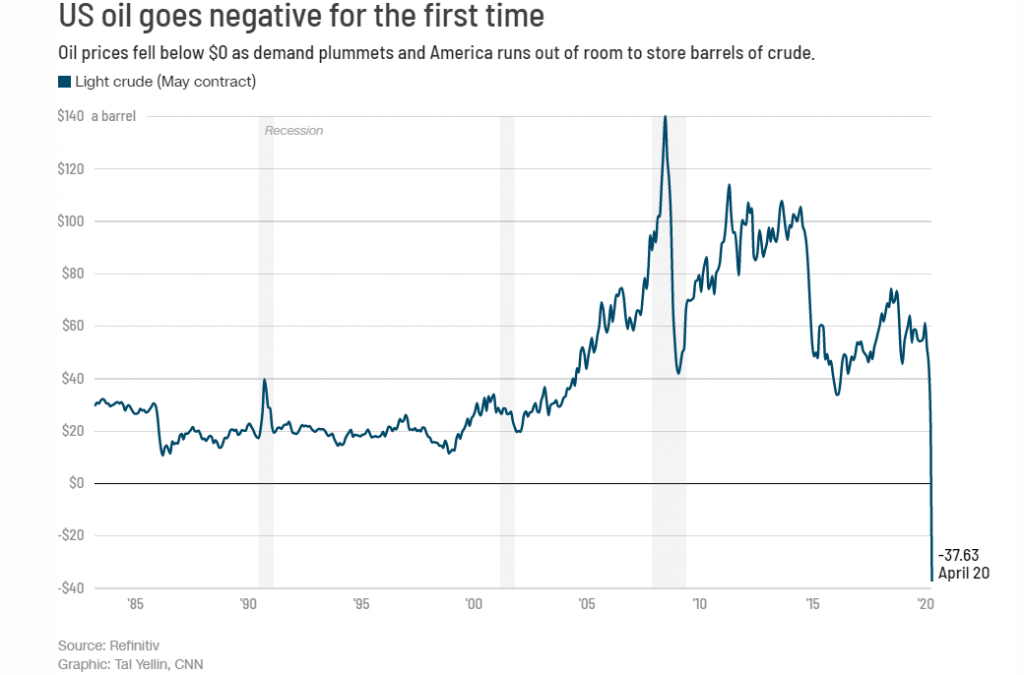
Image Source: https://edition.cnn.com/2020/04/20/business/oil-price-crash-bankruptcy/index.html
Saudi Arabia and Russia Engage in a Price War
Russia and Saudi Arabia kicked off an oil price war in mid-March 2020, at a time when the world is dealing with a pandemic, dwindling supply chains and grounded flights. In the OPEC meeting, held on March 6, 2020, Russia refused to cut its oil production levels. After years of allowing US shale producers to free ride on higher prices, President Putin decided to put his foot down.
Saudi Arabia retaliated by increasing its production and providing discounts to buyers, to increase its market share. On March 9, Brent Crude plunged 24%, its worst decline in 30 years. WTI fell to its lowest in one day since 1983.
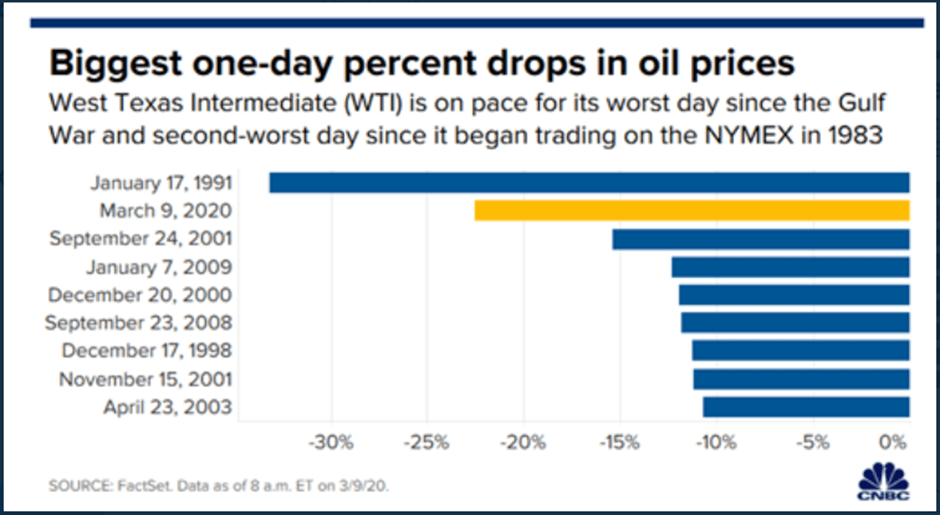
Image Source: https://www.cnbc.com/2020/03/08/oil-plummets-30percent-as-opec-deal-failure-sparks-price-war-fears.html
As the story unfolded, the global financial markets declined to the worst levels since the 2008 financial crisis, in the week starting March 9, 2020. Dow Jones lost 2,000 points, while the UK FTSE lost £125 billion in a single day. Nikkei fell over 5% and other European markets plunged 8%, in the worst decline since the debt crisis.
Under intense pressure from the US, Saudi Arabia and Russia decided to end their bitter price war in early April 2020. OPEC and its allies decided to cut production by about 10 million barrels/day in May and June 2020. Russia and Saudi Arabia also agreed to cut production by around 8.5 million a day each to balance market forces.
Despite this effort to salvage the situation, the supply of oil is massive in relation to demand. Demand is down by about twice the production cut levels. About 20 super tankers filled with oil from Saudi Arabia languish at US oil ports. Oil price forecasts for both May and June 2020 remain low.
With the Chinese economy slowly restarting, oil prices could see a hike. On May 6, 2020, Brent Crude rose 0.1%, while US WTI rose 0.2%, as reports showed a rebound in China’s crude oil imports. But President Trump’s aggressive tactics and arm-twisting might put a spoke in this wheel too.
The US and its Aggressive Policies
President Trump’s aggressive stance against Saudi Arabia might have been a game changer in normal market conditions but will certainly not help in this over-supplied oil market. Although US foreign policy has been to arm-twist nations into reducing oil supply, while its own shale producers fail to follow to the same principle. Over half of the North American supply cuts have come from only three companies, Chevron Corp, ConocoPhilips and Occidental Petroleum Corp. Many companies are yet to announce output cuts.
President Trump had assured the OPEC+ that US producers will cut their own production on Mexico’s behalf, when the latter disagreed on a major supply cut. While Mexico would remove 100,000 barrels a day, the US would cut 300,000 barrels a day. Can the President’s word drive a decline in American production?
On April 22, 2020, President Trump ordered the US Navy to shoot down Iranian boats that trouble US ships. On April 30, 2020, he warned Saudi Arabia to cut oil supply or risk losing US military support. Such aggressive acts are unlikely to help bring together global producers to combat this crisis.
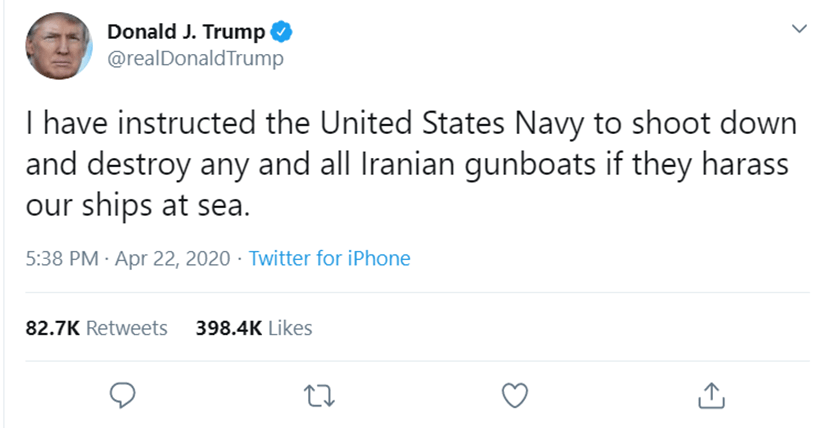
Now, the President is threatening further tariffs on China, to hold them accountable for the COVID-19 pandemic. This could be a further blow to the global oil demand. Heightening of US-China trade tensions would push back global economic recovery, even after the lockdowns begin to cease.
Long-Term Impact on the Oil Industry and Countries
The COVID-19 crisis and the huge decline in oil prices threaten the stability of the global oil industry. It could reframe how the financial community thinks about investing in this industry, which is beset by geo-political tensions, demand destruction and slow transition to low-carbon alternatives. This downgrade in investability will likely continue for a long time, hugely impacting the sector. The energy sector valuation on the S&P 500 index is down 80% from a decade ago.
Also, declining oil prices will impact many smaller countries that are struggling economically. Countries like Oman and Nigeria are struggling with debt. Countries with politically fragile governments will suffer like Iraq, which is already dealing with the third prime minister-designate in as many months. The country is struggling to adhere to the OPEC’s oil supply cuts. Iraq is OPEC’s second largest oil producer, and its lack of enthusiasm could hurt the group’s efforts to bring down the global supply glut.
In Venezuela, people are already dealing with hyperinflation and severe shortages. If prices average below $30 through 2021, budget deficits in many oil producing countries, like the UAE, Ghana, Kuwait, Algeria and Iran, will become severe.
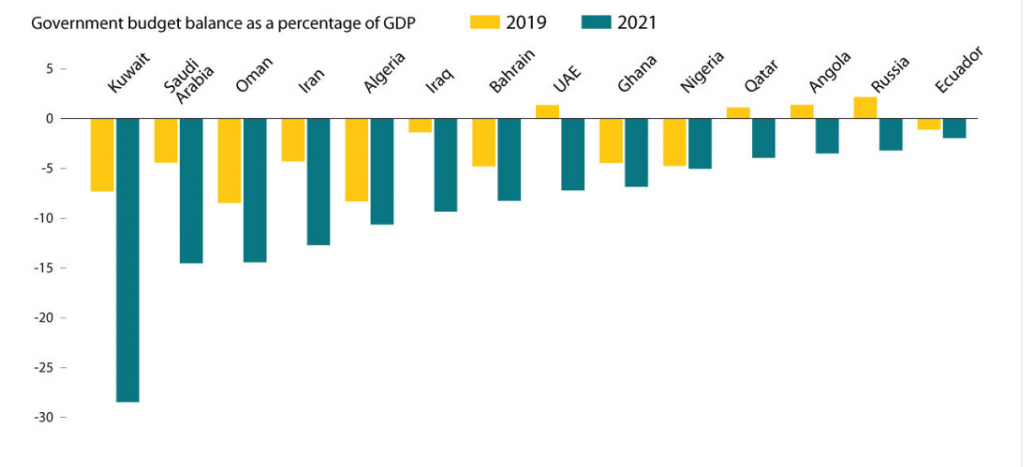
Image Source: https://www.csmonitor.com/Business/2020/0424/Where-does-an-oil-crisis-hit-first-Not-where-you-might-expect
Many of these countries will seek financial assistance from the IMF and World Bank. The worry is that China holds a large part of the external debts of many of these countries. Since 2004, the country has given $152 billion in resource-backed loans to various Asian, African and Latin American countries. Much will depend on how far China will cooperate with other G-20 countries to support a debt moratorium.
It is now becoming evident that many oil-producing nations will have to diversify their economies, from oil exports to other areas of revenue generation. If they fail to do so, this 2020 oil crash could lead to further crises in the future. It all depends on how soon COVID-19 spread is controlled and the virus decides to bow out.
Reference Links
- https://www.cnbc.com/2020/05/07/oil-markets-us-crude-inventories-coronavirus-crude-output-in-focus.html
- https://www.reuters.com/article/us-global-oil-production-graphic/half-of-announced-north-american-oil-cuts-come-from-just-three-companies-idUSKBN21Z26C
- https://foreignpolicy.com/2020/04/23/the-coronavirus-oil-shock-is-just-getting-started/
- https://www.bbc.com/news/business-52350082
- https://www.worldoil.com/news/2020/4/9/saudi-arabia-and-russia-end-their-oil-price-war-with-output-cut-agreement
- https://www.csmonitor.com/Business/2020/0424/Where-does-an-oil-crisis-hit-first-Not-where-you-might-expect
- https://www.iea.org/reports/oil-market-report-april-2020
- https://www.reuters.com/article/us-global-oil-opec/iraq-emerging-as-opecs-main-laggard-in-making-record-output-cut-sources-idUSKBN22I1CB
- https://fortune.com/2020/04/14/trump-oil-deal-inside-story-saudi-arabia-russia-price-war-ended/
- https://www.economist.com/finance-and-economics/2020/03/12/no-one-is-likely-to-win-the-oil-price-war







